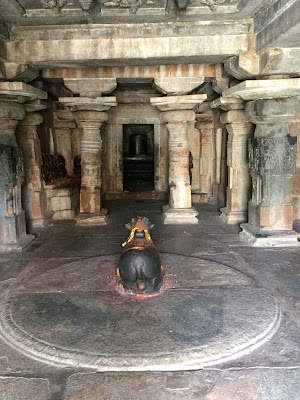The Enchantment of Avani
A place can charm . A few enchant.
These latter hold within them an indescribable element of mystery , a touch of the occult . Doddagaddavalli is a prime example . But before that was ....Avani .
But the real attraction of the place is the group of hoary temples, huddled within a fort like compound at the foot of the hill, collectively called The Ramalingeshwara Group and protected by ASI. The individual temples are named after the characters from Ramayana and are a medley of different styles as they have been renovated and remodeled by various dynasties , Chola and Vijayanagara primarily, that got control of the region down the centuries.
The Nolambas, though considered minor players in the political history of the land, were surely a colourful lot. Claiming descent from the Pallavas , they consolidated enough power to seem a threat to the other powers like the Gangas, The Cholas, The Rashtrakutas , The Vaidumbas etc. Curiously, they had little imperialistic intentions , content with paying tribute to one or the other of those, so long as they enjoyed autonomy over the territory they held - Nolambalige or Nolambavadi . They did have marital alliances with their overlords and provided military support where gain was to be had. They make only a short chapter in a history text, but they have ensured their place in the roll of honour for the sheer brilliance of their artistic legacies , not the least of which is the Avani group. .
Avani now celebrates Festivals and Fairs centered around Sita Devi , but if the oldest shrine is considered, the foundation cult seems to have been worship of Shakthi , the female principle of Shiva , in her martial form.
The Lakshmanalingeshwara Temple, dated between 925 to 940 CE , has in its sanctum the biggest Shiva Lingam among the group. Nevertheless, the presence of Shakthi is overpowering. The outer walls, which have no Koshtas ( niches) are sprinkled over with relief sculptures , most of which are female forms of terrifying character. Like Kali, Chamunda, Bhairavi , with even the attending ladies sporting a wild look.
In addition to the Devis on the walls of the above temple, are representation of Shiva too in dynamic forms . So the over all scheme of the temple seems to celebrate Power , Subjugation and Dominance. It is tempting to think that the shrine was built specifically as an Affirmation or Visualisation of the King's supremacy over his rivals.
During the 9th and 10th centuries, in the South, there was a custom or a Rite of Honour that involved giving up one's life voluntarily , usually by violent means like disemboweling or beheading oneself in the presence of Pidari, the Martial Mother, the Southern Female Power ( later merged with the Pan Indian Kali or Durga.) Such offerings to Pidari were usually for the Glory of the King. And Pidari was the Guardian Deity of most habitations, most notably of nearby Kolar , the first Capital of The Western Gangas that was coveted by the Cholas. Pidari continues to be the tutelary deity in Kolar , but with a change of Name as Kolaramma and blood offerings are no longer made.
Looking at the wild Devis glowering down from the walls of the Avani temple, it is very tempting to imagine that religiously sanctioned self sacrifices ( Atma Bali) could have occured regularly here. On a silent, darkening evening, with no sound of bells or chantings, this imagination becomes almost a conviction.....and thoughts fly to the Bengaluru State Museum, where sits the gloriously attractive Pidari of Avani , far from her original home somewhere near this Lakshmanalingeshwara temple .
The museumed goddess ( above) had a shrine by the tank and long after the Nolambas had disappeared from the scene, she had continued to protect the townsfolk against other enemies - The Epidemics, as Muthyalamma . Finally, with Time catching up , her shrine fell and she had to be moved to the Museum.
Avani means Earth. And like the Earth, Avani is eternally enchanting.







Comments